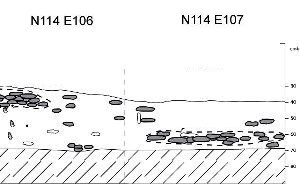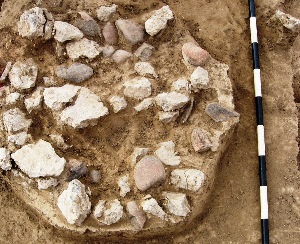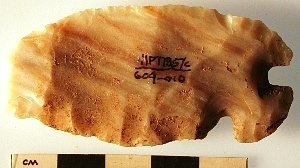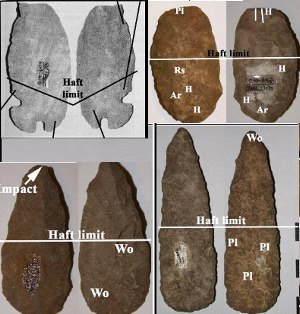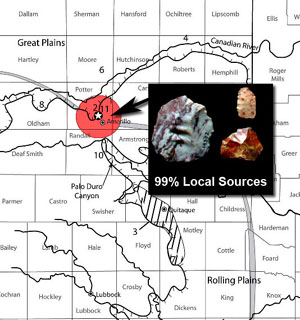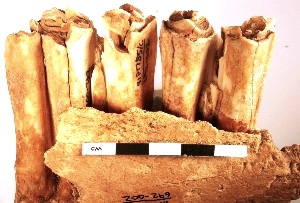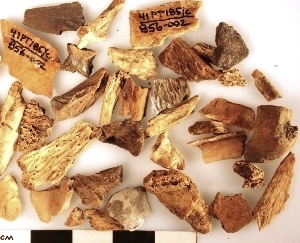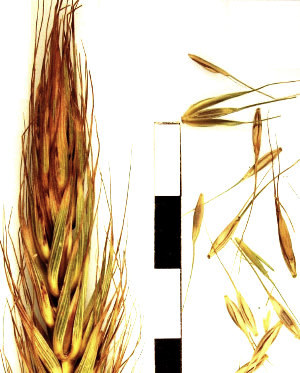Evidence of Late Archaic Campers at the Pipeline Site
Block excavations underway at the Pipeline Site, with West Amarillo Creek along the tree line. |
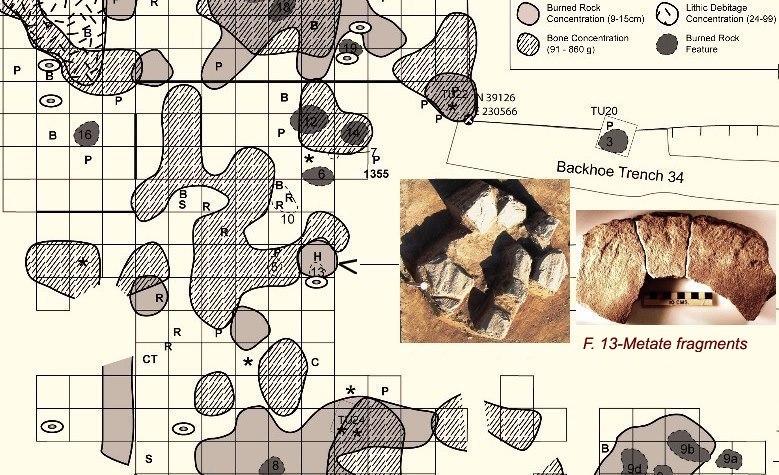
Distribution map of artifacts, features, and lithic concentration (tool-chipping) areas. Shown in photos are Feature 13, a cluster of inverted metate fragments as they were found, and after refitting. Enlarge to view full map. |
Non-burned rock features included a badly weathered, inverted bison skull with a partially crushed top of the skull. Another feature contained multiple pieces of half a metate, or grinding slab. A third consisted of two large natural rocks that were carried into this site by humans. Burned Rock AnalysesTwo types of technical analyses were conducted on burned rock samples selected from the various features. A chemical approach, lipid residue analysis, was preformed on 45 burned rocks from at least 10 features. Based on lipid analyses, almost all the burned rock samples had residues attributable to plants, with many additionally registering traces of animal fats. Results are as follows: 37 percent of the burned rocks sampled came in contact with high to very high fat content plant seeds or nuts. Another 40 percent yielded high to very high fat content plant (seeds or nuts) with a trace of animal products. Minimally, five samples (13.2 percent) yielded a combination of large herbivore fatty meat and plants, three other samples (8 percent) yielded combinations of plant and animal. The large herbivore (likely bison) and plant residues were identified from at least six cultural features. Cholesterol, the lipid biomarker of animal products, was present in almost half (45 percent) of the identified residues.
Fragments of the same rocks analyzed for lipid residues were also subjected to this analysis. Of these, 14 burned rocks (34 percent) yielded lenticular starch grains; 9 (22 percent) yielded damaged starch grains from processing the natural grains; and 13 (32 percent) yielded gelatinized starch grains. The gelatinization was created by exposure to heat and water. The lenticular starch grains were identified as Canadian wildrye (Elymus canadensis) grass. Damaged starch grains occurred during grinding or pounding of the seeds. Stone ToolsA relatively narrow range of stone tools was recovered from these campsites. This includes 133 chipped stone tools that represent at least five different functional classes based on size and shape characteristics. The formal chipped stone tools include 21 dart points and fragments, 21 bifaces, 8 scrapers, one drill base, and one uniface. Over 70 edge-modified pieces or informal tools reflect a range of minor edge alterations and functions. Ten metate fragments and one mano fragment also were present. One of the dart points and ten of the dart point bases are clearly corner-notched, and these have more or less a stemmed appearance. Corner-notched points with such pronounced stems have not been previously reported among Late Archaic sites in the Texas Panhandle. Another of the nearly complete corner-notched points has the more common wide expanding stem, and low tangs, but it is definitely in the minority here. One of the most interesting chipped-stone tools is a nearly complete corner-tang knife. Not only was this a rare discovery in the middle of a campsite, but it had an unusual context. It was found cached under a large natural rock away from any recognizable feature. High-powered use-wear analysis on this unwashed knife indicates it was hafted and used to cut soft hides and starchy plants. However, subsequent starch grain analysis failed to find any starch grains. This unusual piece was manufactured from local Alibates; thus, it was not traded in from central Texas, but made locally. The high-powered use-wear analysis on a suite of chipped-stone tools that included projectile points, bifaces, and scrapers identified haft-wear on most formal tools. That in itself may not seem unusual, but most often this is usually just speculated upon in most analysis. Here, the haft-wear identified on most formal tools extends to about midway along the artifact no matter what its size. This was true on bifaces, end scrapers and a couple of the more completed projectiles. This reveals a consistent hafting technique within this Late Archaic assemblage. It also reflects a specific behavior and means of securing these tools to a shaft or haft. Raw MaterialThe lithic debitage (N = 212) is represented by 76 percent Alibates from the local source area some 57 km to the north. Unidentified debitage accounts for 8.7 percent, with Tecovas a distant third with only 5 percent. Local Potter chert accounts for 4.6 percent, and local Ogallala gravels represent less than one percent. A few Edwards chert pieces, likely from the Callahan Divide region 350 km to the south, and 10 obsidian pieces from north-central New Mexico were also identified. The obsidian was sourced by x-ray refraction technique to three different outcrops: the Valles Rhyolite, the El Rechuelos Rhyolite, and the Cerro Toledo Rhyolite in north-central New Mexico. These sources were represented by an equal number of pieces. One piece was more closely linked to modern glass and one “unknown” piece exhibits chemistry more similar to a mafic or intermediate volcanic rock. These latter nonlocal pieces indicate limited contact or trade with groups from adjacent regions. It is well established that the Later Plains Village Antelope Creek populations traded for New Mexico obsidian some 800 years later. The east-west trading in obsidian from central New Mexico out onto the Plains during the Antelope appears to have started at least during the Late Archaic times by 2400 B.P. The extensive use of the local, high quality Alibates indicates these Late Archaic populations were well acquainted with, and used the local lithic resources. It may also indicate this is this populations home territory. To aid in the visual identification of the different raw material types used by these prehistoric populations in this project area, and to enable correct sorting between the visually close appearance of Alibates and Tecovas, Instrumental Neutron Activation Analysis (INAA) was conducted. This analysis included 71 cultural pieces from the three sites, as well as 55 pieces of natural raw materials. The natural pieces included 30 pieces of Tecovas from six different source localities in the panhandle and 25 pieces of Alibates from three sources. The Alibates sources include the Alibates National Monument, the same Quartermaster formation outcrops on the northern side of Lake Meredith opposite the National Monument, and a high Pleistocene gravel terrace located downstream from the main outcrop where State Highway 71 crosses the Canadian River. The INAA results determined that the chemical fingerprint of Tecovas is distinguishable from that of Alibates. Although the current Tecovas sample is quite limited in number, some chemical differences in the Tecovas source areas were detected by county. This is extremely significant because as more Tecovas samples are analyzed, it may become possible to determine which specific county the sample came from. Animal BoneA relatively high frequency of faunal bones was recovered (5,337 pieces). About 18 percent of the fragments were sufficiently complete to identify. Nearly 940 pieces were identified as bison bones, with only 1.6 percent identified as non-bison. Most bones were highly fragmented, with only about 26 percent considered complete or nearly complete. The high percentage of fragments indicates that not only was meat targeted, but bone marrow and bone grease were extracted. The proximal (roughly 12.5 percent) and distal ends (9.8 percent) of long bones that were identified and measured to determine sex indicate that the kill occurred a considerable distance from this camp as the bulky skull with little meat and the vertebrae were drastically underrepresented. Measurements on the 25 mature articular ends of the intact long bones indicate 41 percent were male and 59 percent were female. Based on a combination of data, including the fusion rates of the long bones, the sex differences documented, and the animal ages established from analysis of the teeth and mandibles, at least 13 bison were represented. This includes at least three males and six females, plus one newborn animal. Based on individual bison tooth eruption and wear patterns the season(s) of the kill(s) was determined to be fall. This is probably true for both campsites. The out of season new born bison identified is not all that unusual in natural herds. The non-bison specimens include a single dog mandible with cut marks and a few scattered deer elements. These undoubtedly represent other probable food resources. Other animals identified include; badger, mink, turtle, and prairie dog, but these are considered intrusive to the Late Archaic component. This interpretation is based on their overall lighter color, lack of similar weathering patterns, and less extensive root etching in comparison to the bison bones. Plants in the DietIn addition to the bison that served as the major meat resource, wildrye grass seeds also provided a significant contribution the Late Archaic diet at this locality. Starch grain analysis on the burned rocks (see above) coupled with wildrye seed starch on 75 percent of the metate fragments analyzed, clearly documents this plant food. In fact, the starch grain analysis has documented the full range of grass seed processing activities. Here, damaged wildrye starch grains were on a hammer, ground grains were on metates, and cooked starch, as indicated by gelatinized grains, were on the burned rocks. This finding is significant inasmuch as the plant gathering aspect of the hunter-gatherer ecomomy is mostly based on speculation. Due to poor preservation of plant remains, most macrobotanical analyses from open mobile hunter-gatherer camps have yielded limited or no evidence for plant use. |
|
